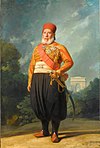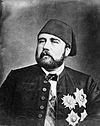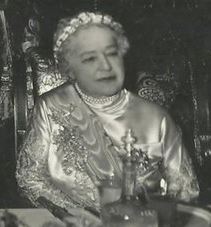| Monarchs of Egypt and Sudan | |
|---|---|
 | |
 Montage of monarchs and their offspring | |
| Details | |
| Style | Wāli (unrecognised Khedive) of Egypt (1805–1867) Khedive of Egypt (1867–1914) Sultan of Egypt (1914–1922) King of Egypt (1922–1951) King of Egypt and the Sudan (1951–1953) |
| First monarch | Muhammad Ali Pasha |
| Last monarch | Fuad II |
| Formation | 18 June 1805 |
| Abolition | 18 June 1953 |
| Residence | Cairo Citadel (1805–1874) [1] Abdeen Palace (1874–1952) [2] |
| Pretender(s) | Fuad II |


Monarchs of the Muhammad Ali dynasty reigned over Egypt from 1805 to 1953. Their rule also extended to Sudan throughout much of this period, [a] as well as to the Levant, and Hejaz during the first half of the nineteenth century. [3] The Muhammad Ali dynasty was founded by Pasha Muhammad Ali, an Albanian commander in the expeditionary force sent by the Ottoman Empire in 1801 to dislodge the French occupation of Egypt led by Napoleon Bonaparte. The defeat and departure of the French left a power vacuum in Egypt, which had been an Ottoman province since the sixteenth century, but in which the pre-Ottoman Mamluk military caste maintained considerable power. After a three-year civil war, Muhammad Ali managed to consolidate his control over Egypt, and declared himself Khedive of the country. The Ottoman government refused to acknowledge this title, instead recognizing Muhammad Ali by the more junior title of Wāli (roughly equivalent to a governor or viceroy) on 18 June 1805, making Muhammad Ali the successor to Ahmad Pasha in that position. [4] In the years following his consolidation of power, Muhammad Ali extended Egypt's borders southwards into Sudan, and eastwards into the Arab-majority Mashriq, particularly the Levant. In 1840, his demand for hereditary control of Egypt and Sudan to be passed to his heirs and successors was accepted and confirmed by the Convention of London, but he was compelled to agree that, upon his death, control over his territories in the Mashreq would revert to the Porte. [5]
Contents
- List of monarchs (1805–1953)
- Wilayah/Unrecognised Khedivate (1805–1867)
- Khedivate (1867–1914)
- Sultanate (1914–1922)
- Kingdom (1922–1953)
- See also
- Notes
- References
- Bibliography
Muhammad Ali had a 43-year reign, the longest in the history of modern Egypt. [6] Termed the "father of modern Egypt," he is viewed in Egyptian historiography as the dynasty's most important ruler, due to his massive agricultural, administrative, and military reforms. [3] His son, Ibrahim Pasha, was the shortest-reigning monarch of the dynasty. [6] The duration of his rule varies from one source to another, depending on whether or not his reign as regent is taken into account. Contrary to what the short length of his reign might suggest, Ibrahim Pasha was far from being a historically negligible figure, although most of his significant achievements were made before his accession to the throne. His successor, Abbas Helmi I, a traditionalist described by Lord Cromer as "an Oriental despot of the worst type," [7] reverted many of his predecessors' reform-minded measures, and is considered the most controversial ruler of his family. [8]
Sa'id Pasha and Isma'il Pasha were far more open to Western influence, and continued the process of expansion and modernization set up by Muhammad Ali, but on a more lavish scale. Isma'il Pasha is especially notable for his inauguration of the Suez Canal and for his Haussmann-inspired reconscrution of Cairo. However, his costly policy of Europeanisation left the country bankrupt; as a consequence, European creditors greatly expanded their influence over Egypt and Sudan's internal affairs. [9] Isma'il's son, Tewfik Pasha, became increasingly powerless following the Urabi revolt, and was turned into a figurehead ruler following the establishment of British control in 1882. [10] After his death, his son, Abbas Helmi II, tried unsuccessfully to detach himself from the influence of the British, who ended up deposing him in 1914. The following reign, that of Hussein Kamel, lasted only three years and was thus little more than an interregnum. [11] Hussein Kamel's successor Fuad I was a far more historically significant figure. Described by historian Philip Mansel as "the last great royal patron of history," [12] his reign was marked by the Egyptian Revolution of 1919, and the United Kingdom's resultant recognition of Egyptian independence. The British, however, refused to include Sudan within the sphere of this recognition, and continued to abide by the terms of the Anglo-Egyptian Condominium. Fuad's son, Farouk I, was Egypt and Sudan's penultimate monarch. After his forced abdication following the Egyptian Revolution of 1952, his infant son Fuad II continued to reign as a nominal king-in-exile until the monarchy was formally abolished on 18 June 1953. [b]
Rulers of the Muhammad Ali Dynasty governed Egypt and Sudan as absolute monarchs until constitutional rule was established in August 1878. [13] Following the dissolution of the Ottoman Empire, the Egyptian and Sudanese monarchy emerged as the most important in the Middle East and the wider Arab world. [14] Finding themselves as mere figureheads during the period of British control, Egypt and Sudan's monarchs saw their powers increased following the recognition of independence, and the subsequent adoption of the 1923 Constitution, the most liberal in the country's history. [15] Although King Fuad I often ruled as an autocrat, partly because he repeatedly overrode some provisions of the Constitution, Egypt and Sudan had the freest parliament in the region. [16] During Fuad's reign and that of his son, Farouk, the country witnessed six free parliamentary elections and enjoyed a free press as well as an independent judiciary. [17] According to historian Philip Mansel, "the Egyptian monarchy appeared so splendid, powerful and popular that King Farouk's ignominious end seems inexplicable." [18] The Muhammad Ali Dynasty's downfall is often regarded as having begun with the Abdeen Palace Incident of 1942, which greatly discredited the King. [19] It accelerated with the growing discontent of Egypt's armed forces following the country's defeat in the First Arab-Israeli War. Disgruntled members of the military formed the Free Officers Movement, which led a coup d'état on 23 July 1952, thereby marking the beginning of the Egyptian Revolution of 1952. [20] The toppling of the monarchy, and the resultant establishment of a revolutionary republican government, was the first of its kind in the modern Arab world, and was a crucial event in the region's history; it accelerated dramatically the rise of Pan-Arabism, and had a domino effect leading to similar military overthrows of the monarchies of Iraq (1958), North Yemen (1962), and Libya (1969). [21] Egypt has had a republican form of government since the end of monarchical rule. Although the establishment of genuine democratic rule was one of the six core principles of the Revolution, [22] political parties were banned in 1953 and the country was turned into a military dictatorship. [23] The thriving pluralism that characterized political life during the latter period of the Muhammad Ali Dynasty's rule was thus brought to an end. Even though a multi-party system was officially restored in Egypt in 1976, the country has never recovered the level of political freedom it had enjoyed during the monarchy. [24] In common with most deposed royal families, the Muhammad Ali Dynasty was initially vilified by the new revolutionary regime. Nonetheless, it has undergone re-evaluation in recent years; nostalgia for the former monarchy has been growing among some in Egypt, largely fuelled by the airing in 2007 of a hugely successful serial about the life of King Farouk I. [25]






























